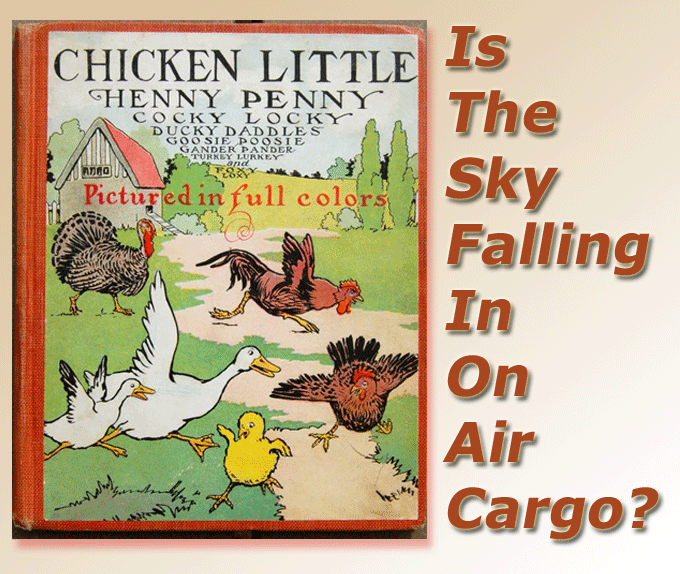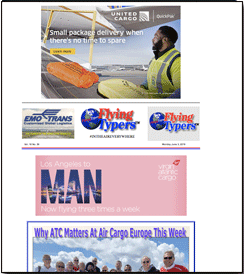
While the mood in Munich’s maze of
exhibition halls was decidedly – perhaps surprisingly – upbeat,
a deluge of negative data and forecasts were raining down.
And for what it is worth Chicken Little,
Henny Penny, Cocky Locky, Ducky Daddles, Goosie Poosie, Gander Pander,
Turkey Lurkey and Foxy Loxy are all on the record here.
Yes, our view may be a children’s
fairy tale, but isn’t it so that sometimes the gloom and doom forecast
turns out like the unexpected last boom in air cargo that no one, including
the crystal gazers at IATA Cargo saw coming?
Everyone was smiling at Munich and the band
just played on as far as we could tell.
Here is the reality check.
Spank That World Bank
The World Bank, for example, downgraded
its 2019 trade volume forecast by a full percentage point, predicting
growth of just 2.6%.
If correct, this year would see the slowest
rate of trade expansion since the financial crisis a decade ago.
The World Bank also downgraded its forecast
for global economic growth by 0.3 percentage points to 2.6%, with the
U.S.-China tariff war named and shamed as the key architect and forward
risk to growth.
IATA Bearish Maybe Not Unberishable
IATA’s forecasts tend toward the bearish
and conservative, but the latest annual outlook was downright glum. It
announced a downgrade of its 2019 outlook for the global air transport
industry to a $28 billion profit (from $35.5 billion forecast in December
2018), with margins being squeezed by “rising costs right across
the board,” including labor, fuel, and infrastructure, according
to Alexandre de Juniac, IATA’s Director General and CEO.
 For
air cargo, after an “exceptional performance” in 2017 of +9.7%
growth, IATA said cargo demand growth slowed to 3.4% in 2018 and it forecast
“flat” growth this year, with cargo volumes of 63.1 million
tons marginally down from the 63.3 million tons recorded in 2018 “because
of the impact of higher tariffs on trade”. For
air cargo, after an “exceptional performance” in 2017 of +9.7%
growth, IATA said cargo demand growth slowed to 3.4% in 2018 and it forecast
“flat” growth this year, with cargo volumes of 63.1 million
tons marginally down from the 63.3 million tons recorded in 2018 “because
of the impact of higher tariffs on trade”.
IATA added: “Cargo yields are expected
to be flat in 2019 after a 12.3% improvement in 2018, as cargo load factors
fall further, and supply-demand conditions weaken.”
According to De Juniac, stiff competition
among airlines is preventing yields from rising, while the weakening of
global trade “is likely to continue as the U.S.-China trade war
intensifies.”
“This primarily impacts the cargo
business, but passenger traffic could also be impacted, as tensions rise.
Airlines will still turn a profit this year, but there is no easy money
to be made.”
And who in air freight doesn’t hate
a lack of easy money?
 Follow
The Herdman Follow
The Herdman
Certainly not Andrew Herdman, AAPA Director
General, who glumly noted that since the last quarter of 2018, air cargo
volumes had recorded declines as “unresolved disputes and the imposition
of trade tariffs led to a marked slowdown in international trade flows.”
 Sun
Will Be Up To Morrow Sun
Will Be Up To Morrow
Cathy Morrow Roberson, founder and head
analyst at Logistics Trends & Insights, said IATA downgrades will
mean lower volumes for global freight stakeholders. “This, in turn,
is resulting in stakeholders culling less profitable accounts in favor
of more profitable ones,” she told FlyingTypers. “In
addition, investments in operations continue in order to improve efficiencies
as well as visibility into shipments.”
Tomorrow The World ACD
Just in time for German Cargo Week—WorldACD’s
latest report was also anything but uplifting, as the analyst firm noted
that April 2019 was the first month in which all regions, without exception,
were confronted with the growing impact of adverse market movements that
started last September.
“For both incoming and outgoing air
cargo, each region returned year-on-year volume figures worse than the
first quarter of the year, underscoring the clear slowdown in global business.”
 The
withdrawal of more capacity could be one option for carriers. “Airlines
will continue to park freighters to equalize with demand, however belly
capacity will continue to fly with associated operating costs,”
said Peter Stallion, an air cargo derivatives broker at Freight Investor
Services. The
withdrawal of more capacity could be one option for carriers. “Airlines
will continue to park freighters to equalize with demand, however belly
capacity will continue to fly with associated operating costs,”
said Peter Stallion, an air cargo derivatives broker at Freight Investor
Services.
“This makes the supply/demand element
far less flexible than in sea-freight given the dual-use requirement for
the aircraft. As such, parking freighters won’t have a considerable
impact in supporting rates. Rather, it aligns carrier costs with demand.”
Looking ahead Herdman says, trade tensions
and the further erosion of business confidence could undermine the growth
prospects of Asian carriers going forward. “The region's airlines
are proactively exploring new opportunities for growth, whilst carefully
managing capacity expansion and implementing measures to contain costs
in a bid to navigate successfully through the ongoing challenges,”
he added.
Cargo Has A Friend In Fried
 FlyingTypers is adept at finding rays of light in the murk and, thankfully, BrandonFried,
Executive Director at The Airforwarders Association based in the U.S.,
stepped up to the plate. FlyingTypers is adept at finding rays of light in the murk and, thankfully, BrandonFried,
Executive Director at The Airforwarders Association based in the U.S.,
stepped up to the plate.
“Change is the one constant for which
forwarders are always prepared and the current uncertain global situation
continues to bring lots of challenges,” he said. “However,
while the headwinds may appear strong, so are the opportunities. For instance,
trucking waiting times along the Southwest border have actually resulted
in an uptick in air cargo for customers unwilling to endure long clearance
lines at the checkpoints.
“As for the China-U.S. tariff situation,
forwarder customers continue to rely on our members for the best alternatives
in navigating the challenge by providing the most prudent transportation
options possible.
“That said, we are prepared for a
less robust upcoming few months compared to the good fortunes experienced
in 2018.”
SkyKing
|




 Vol.
18 No. 38
Vol.
18 No. 38